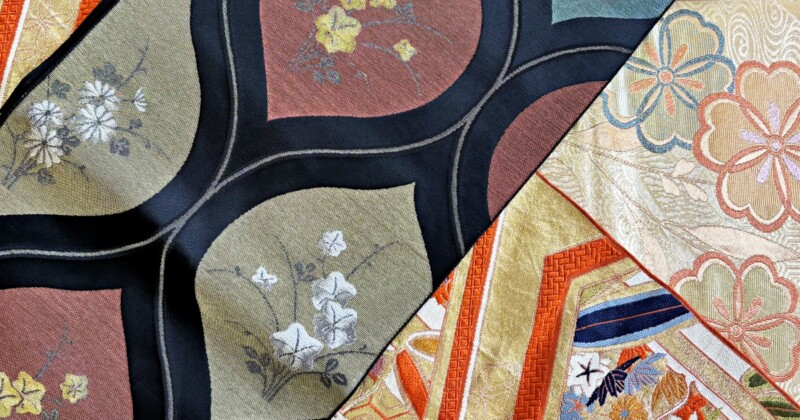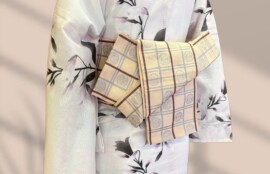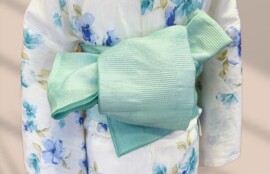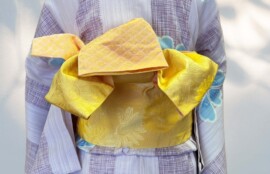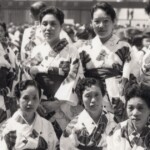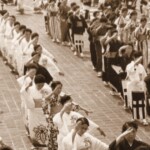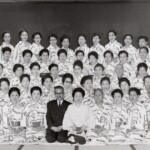The OBI is an essential item when wearing a Kimono.
It is said that the OBI has a longer history than clothing. The meaning and shape of the OBI
have changed over the years. How did it change to what it is today?
History of OBI
|Before the Edo Period
It is said that the obi originated in primitive times when a long, thin object was tied around
the body to insert tools used in hunting. And also said that tying clothes had a magical meaning,
such as sealing evil spirits and diseases from entering through gaps and holding down one’s
own sanity from slipping away.
In the Nara period (710-794), under the influence of continental cultures such as Tang (China),
the OBI began to take on decorative meaning. For men, in addition to the practical purpose of
hanging weapons, it also had the purpose of showing off their status.
During the Heian period (794-1185), both men and women wore clothing in two pieces, top and
bottom, so the OBI was meant to be decorative.
For women, around Azuchi Momoyama period (1568-1600), they changed from their previous clothing of Kosode and Hakama to light clothing of Kosode only, and the OBI became more important. The OBI of the time was a braided cord-like item with tassels attached at both ends, which was wrapped around the waist and tied. This is called ‘NAGOYA OBI’ because its technique was introduced from China to Hizen Nagoya (present Saga Prefecture).
And then after that, the width of the OBI gradually became wider.
|After the Edo Period
In the Edo period (1603-1867), the OBI evolved greatly.
The shape of OBI that we see today first came to be during the Kanbun period (1661-1673),
around the time of the 4th Shogun, Tokugawa Ietsuna. Before that time, the OBI were narrow
and were tied in a way called “Tsukkomi Obi,” in which the ends were not tied but tucked
between the OBI.
During the Enpo period (1673-80), around the time of the 5th Shogun, Tokugawa Tsunayoshi,
the popular Kabuki actor, Uemura Yoshiya, appeared on stage wearing a wide OBI with lead
stuffed into both ends so that the both ends hung down, known as the ‘Yoshiya Musubi’, and
became a huge hit. This led to the use of wide and long OBI.
Later, during the Genroku period (1688-1704), the OBI became wider and longer, eventually
taking on the shape we see today.
And after the Kyoho period (1716-35), this size became the standard for OBI. In this period,
the OBI was ‘Zentsugara’, which patterns all over the OBI from one end to the other, so there
were no restrictions on how it could be tied, and a variety of different ways of tying it were
developed.
‘Beauty looking back’ by Hishikawa Moronobu (Tokyo National Museum collection)
https://www.tnm.jp/modules/r_collection/index.php?controller=dtl&colid=A60&lang=en
In the End
The obi originated as a thin string band to prevent the garment from becoming loose,
so it was generally tied in front, but later, as obi became wider, it was tied in back as well.
There was a time when unmarried women wore their obi at the back and married women
wore at the front to distinguish whether they were married or not, but this custom gradually
disappeared because it was inconvenient for household.
The Oiran (Courtesans) expressed their “status” by dressing luxuriously and showing off
their costumes and hair ornaments, so it is said that they placed the knot in front where
the patterns and embroidery looked most beautiful.
I hope you enjoyed the history of OBI. Next time, I’ll talk about the different types of OBI.
At Japanese Dance School MIYA, we also offer the ‘Kimono Course’, where you can learn
how to wear a Kimono, including how to tie an OBI.
If you are interested, please contact us HERE.
*There are various theories about the front OBI of the Oiran (courtesan).
*This site contains promotions.
◆CONTACT
https://miya-ds.com/en/contact/
◆TRIAL LESSON
https://miya-ds.com/en/trialsession/
◆JAPANESE DANCE SCHOOL MIYA
https://miya-ds.com/en/
◆MIYANAGI RYU
https://www.miyanagiryu.com

